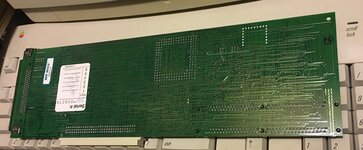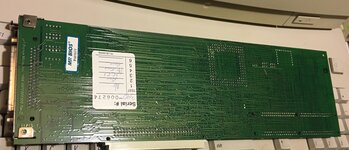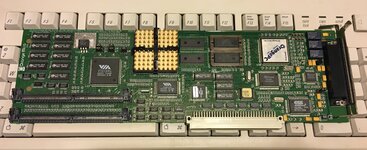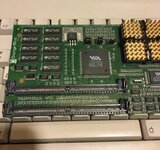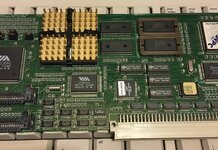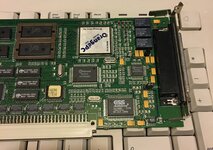for mentioning revised posting limits in the bug tracker. Let's try this again...
These have been a fascination ever since I eight-year-old me tried aimlessly to make my Performa run exe files.
I've acquired several x86 cards over many years and although there are many useful resources to get these up and running, it's always seemed hard to nail down a complete lineage of these things.
There's almost certainly going to be something wrong in this post, but I'm hoping I get it mostly correct and we can improve it over time.
P.S. Most of these pictures are from around the internet, eBay sales, 68kmla posts, etc, and have been brought here in reduced resolution for the purpose of helping others identify their own cards.
~1985 - MacCharlie by Dayna Communications - This standalone module contains an 8088 based computer with one or two 5.25" drives built-in. Styled to sit adjacent to a 128k/512k/e/Macintosh Plus, the MacCharlie also provides an extended keyboard overlay to add missing function keys to the Macintosh keyboard (not the extended keyboard that came with the Plus, however.) All communications to the Macintosh display and from the Macintosh keyboard utilize two RS422 serial connections, which make this best suited for text-based applications. I'm not sure if there were any significant revisions to the MacCharlie.
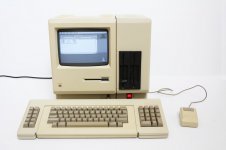
~1987 - PC Transporter by Applied Engineering - This card provides 8086 compatibility for the Apple IIe & IIGS using an NEC V30. This card provides analogue video out by way of an included "ColorSwitch" module. It also provides a header for 5.25" and/or 3.5" diskette drives. Inputs and memory can be shared from the Apple II.
There seem to be two revisions of this card, primarily due to different DRAM form factors. A DRAM upgrade was also produced for the earlier revision.

~1987 - Mac86 and Mac286 by AST Research - These were the first daughterboard-based "DOS compatibility" cards for the Macintosh line.
The Mac86 is designed for the Macintosh SE PDS, while the Mac286 is designed for the Macintosh II line's Nubus connector(s.) The SE's Mac86 was 8086 based non-upgradeable card with one interface for Apple's 5.25" PC diskette drive.
The Mac286 was initially released as a pair of two Nubus cards connected by two ribbon cables. The same Apple 5.25" PC diskette connector is present, though the Mac286 was based on the Intel 80286 and had upgradeable memory and an 80287 coprocessor slot.
The Mac286 was later revised after AST sold both properties to Orange Micro. Orange reportedly made the first small minor revision to improve memory upgradeability, then later redesigned the Mac286 to fit entirely on one Nubus card.
Both platforms used the Nubus interface to accept inputs from the Mac as well as to send video data back to the Mac.
I am unsure if the two boards in the top right are actually considered second revision Mac286. The blotted out AST logos indicate this is probably post-AST, but not sure if Orange actually redesigned this example or not.
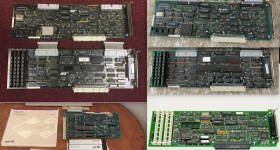
~1990 - Orange386 by Orange Micro - This was a brand new 80386 design based loosely on Orange's revision to the Mac286 (bottom right above.) It retained the single-slot design but employed a second PCB daughterboard on the Nubus card. It also featured one 16-bit ISA slot as well as a second 8-bit slot. The external connector was redesigned for an "octopus cable," which broke out to the same 5.25" PC Drive port, as well as standard PC Serial and Parallel ports. The Nubus interface was used to deliver input from the Mac, and was capable of receiving video data back from the Orange386 as its predecessor did. You could alternatively use a VGA card in one of the ISA slots, and even a sound card in the second slot, if you prefer more than the card's built-in PC buzzer. Orange Micro's accessory kit included a VGA switch for exactly this use.
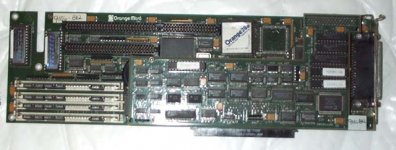
~1993 - OrangePC 200 Series by Orange Micro - Rather than replacing the Orange386 with a single new design, Orange Micro designed several boards and sold several SKU of each board, populated with different features. In press materials and pricelists, Orange seemed focused on selling three main variants of the 200 series: the 210, 250, and 290 models, each a variation of their new 486-based design with or without PCMCIA slot, with or without Serial/Parallel headers, with or without onboard CPU cache, and some boards designed for/populated with a VRM for DX4 chips. Notably, the 210 had a less powerful VGA chip compared to the SVGA on the 250/290.
Some boards had no provision for the DX4 VRM, such as the 250 board pictured center, below. There appear to be two or three PCB versions- the location of the Orange Micro silkscreen and the location of the VRM vary between the images below.
Orange Micro also produced a completely separate design in this same timeframe, seemingly a bridge model between the aging Orange386 and the newer 486-based 210/250/290. This model seems to cause more confusion than others, since it's fundamentally a faster 386-based board, this time with only one 16-bit ISA slot. Due to rapid changes in x86 production at the time, several of the 386 chips compatible with that socket are silkscreened '486.'
I have yet to verify the name of this board, though it does work with the 200-series software like the true 486 models. It's possible this was called "OrangePC 220" (since many seem to refer to a 220 model despite it not being listed with the 210/250/290 in press.) If true, the 210 would be more capable (though perhaps less expandable) than the 220, so not sold on this idea. The version of this board without serial/parallel could be called "OrangePC 200" in this case.

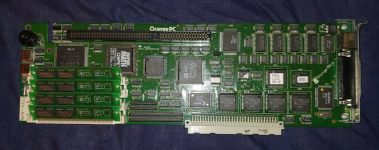
An example of _educational_ pricing for OrangePC cards (May 26, 1994):
----------------------------------------------------------------------------
Model210 486SX/33 4MB VGA Serial/Parallel DOS6 ...$1015
Model210 486DX/33 4MB VGA PCMCIA Slot DOS6 ...$1149
Model250 486SX/33 8MB SVGA PCMCIA Slot DOS6 ...$1505
Model250 486DX/33 8MB SVGA PCMCIA Slot DOS6 ...$1639
Model290 486DX2/66 8MB SVGA Ser/Par PCMCIA 128k cache DOS6 ...$2157
Model290 486DX2/66 16MB SVGA Ser/Par PCMCIA 128k cache DOS6 ...$2531
Model290 486DX2/66 0MB SVGA Ser/Par PCMCIA 128k cache DOS6 ...$1758 no RAM
Model290 486DX4/100 16MB SVGA Ser/Par PCMCIA 128k cache DOS6 ...$2885
Model290 486DX4/100 0MB SVGA Ser/Par PCMCIA 128k cache DOS6 ...$2112 no RAM
PCMCIA Ethernet TP .............................................$ 179
PCMCIA Ethernet BNC ............................................$ 200
PCMCIA Token Ring ..............................................$ 555
----------------------------------------------------------------------------
- complied by Eric Carter (
erichc@yvax2.byu.edu)
~1994 - Houdini & Houdini II by Apple Computer - Upon recognizing market demand for the aforementioned products, Apple decided to design their own in-house x86 cards for select computer models. Apple designed their cards around their computers' PDS, rather than Nubus as Orange/AST had done thus far. Development seemed to begin in the full size Quadra with the 386-based
"Royal Scam Board" (my favorite Apple nomenclature to date,) however the first Houdini model was 486SX-33-based and was only intended for use with the Centris/Quadra 610 (though the 040-PDS it used was standard.) The Houdini used a video loopback cable and internal sound cables to integrate the VGA switching hardware and sound routing into the 486 card, so fast video could be sent directly to the main monitor (similar to the ColorSwitch employed by Applied Engineering, but all in one card, and with sound.) It had an unpopulated header for sound processing, and I believe it was incompatible with the Vibra 16 module included with the later Houdini II boards. Both Houdini and Houdini II included a
MIDI out joystick port on the loopback cable. (MIDI can be made to work using info here:
https://modelrail.otenko.com/retro/power-mac-6100-66-dos-compatible-midi-out) Speaking of the Houdini II, this was Apple's small update to the Houdini, sold with the PowerPC-based 6100 and now using a 486DX/66 CPU with SoundBlaster compatibility in the included Vibra 16 daughter-card. The Houdini system was also adapted to the LC PDS, for sale in the Performa 640CD among other variants of the 630. Apple licensed the Houdini card and its basis to the Reply Corporation, who continued to adapt and expand this lineup to more models before being acquired by Radius in 1996.
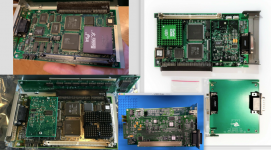
~1995 - 12" 5x86 cards by Reply Corporation - The 6100's Houdini II card was technically an 040 PDS card installed in a 601 PDS adapter. Reply Corporation later released two variants of a full-size 5x86 card specifically for the 601 PDS, one intended for the 7100’s case and one for the 8100’s.
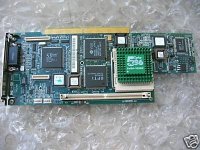
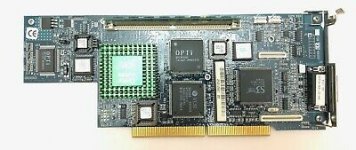
~1996 - OrangePC 300 and 400 series by Orange Micro - After the release of the Houdini cards, Orange took a similarly streamlined approach to managing I/O on their next series of OrangePC cards. The 300 and 400 were a similar design on the x86 side, though 300s were the final design for the aging 12" Nubus interface while 400s were the first to utilize the new 12" PCI interface. Both could support either 486 or 5x86 chips in 5v or 3v, had cache options, and included VGA switching hardware and SoundBlaster compatibility on-board, all accessible via Octopus cable at the back (though different than the Octopus cable for the original Orange386, this new cable seems to work for 300, 400, and 500 series boards. No ISA or PCMCIA expansion was offered.) 340 and 440 were the high-end of each card, and there may have been cards branded '320' or '420' with lesser CPUs and/or without cache, though I cannot verify this.

~1996 - 7" and 12" PC Compatibility cards by Apple Computer- With the PowerPC and PCI transition fully complete, Apple began replacement of their old Houdini line using the PCI interface in their machines. Some machines could support the full 12" PCI design standard, while others required a smaller 7" card. Apple produced at least two distinct OEM designs for the PCI slot- one 7" design based on a 100MHz Cyrix 5x86, and at least one 12" design which was sold in three different versions: 100MHz Pentium with expandable VRAM, 166MHz Pentium with pre-expanded VRAM, and one more based on a Cyrix 133MHz 6x86 PR166 which Apple strongly warns is ONLY for the PowerMac 4400 (and sibling 7220 - I do not have any pictures for this one.) All of these designs feature the same I/O design: Input is passed through the PCI interface from the Macintosh and a familiar sound and loopback cable setup was included, though PCI loopback cables and Houdini loopback cables were not cross-compatible (the MIDI port has been moved to the back of the card itself for all PCI models.) Certain machines such as the PowerMac 7200 and 6400 provide and onboard internal GIMO port, which can be used to carry video loopback without external cables (sound too on the 6x00.) Also onboard each PCI model is a port for connecting a ribbon cable to a second inline Serial/Parallel PCI card.

~1997 - 12" PCI with Pentium MMX by Radius (Reply Corp) - Similar to Apple's last flagship 12" 166MHz Pentium card, this version by Reply features a socket for later MMX processors, upgradeable VRAM, and socketed (cache? ROM?) The loopback, sound, and Parallel/Serial interfaces are identical to Apple's cards.
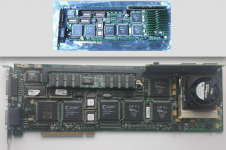
~1998 - OrangePC 500 and 600 series by Orange Micro - These were the last two series' released by Orange Micro, which moved to Pentium MMX/K6-based platforms. All were PCI based, though the 500 series were the last to make use of the existing Octopus cable, the 600 switching instead to direct VGA in and out on the card itself, removing the other ports in favor of software solutions. The 550 and 660 are the top 12" model of each series (540 and PCfx 650 are lower end,) and the 530 and 620 (sometimes marked 626) are the top of each 7" series (520 was lower end.) Orange Micro says each of the 600 series received a version specifically for the G3 Blue & White, which end in the digit 5 (625 for 620, 655 for PCfx 650, and 665 for 660) though it's unclear what changed. Although the PCfx 650 was the first OrangePC marketed towards 3D gaming, the 550 and 660 also included 3D hardware acceleration (in the case of the 650/660 it's an nVIDIA RIVA 128 with 4MB, not sure on the 550. The 620 only emulates 3D.) The OrangePC 540 looks more like an update to the 440 than a variant of the 550. The 550 seems to be the basis for the 650/660.
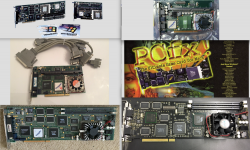
Did I forget anything?
Most useful links (no particular order


www.vogons.org
The small library of software available for the Macintosh platform has always been one of the principal hindrances to the growth of its market share (on...

everything2.com

modelrail.otenko.com
(pg. 93-98)
Manufacturer of upgrades and accessories for Apple II and Macintosh systems. The company went out of business in 2004.

wiki.preterhuman.net
This page looks at the first MS-DOS coprocessor cards for the Macintosh, the Mac286 and its sibling, the Mac86. I have created this page in response to the lack of information about these cards that is publicly available. In 1987, Apple Computer released the first expandable Macintosh computers...

lowendmac.com

ae.applearchives.com
Although PC compatibility isn’t a big deal since Apple’s transition to Intel CPUs in 2006, there is a long history of PC emulation and DOS cards that let Macs run PC operating systems and software. Dayna’s MacCharlie was the first solution to the “problem” of PC compatibility. Introduced on...

lowendmac.com

deskthority.net

















